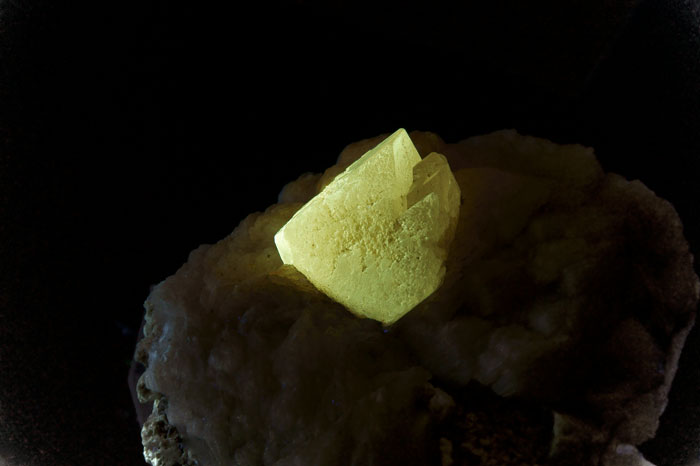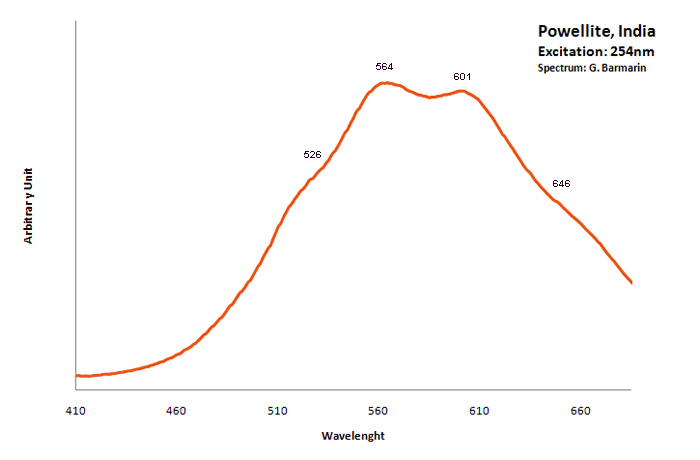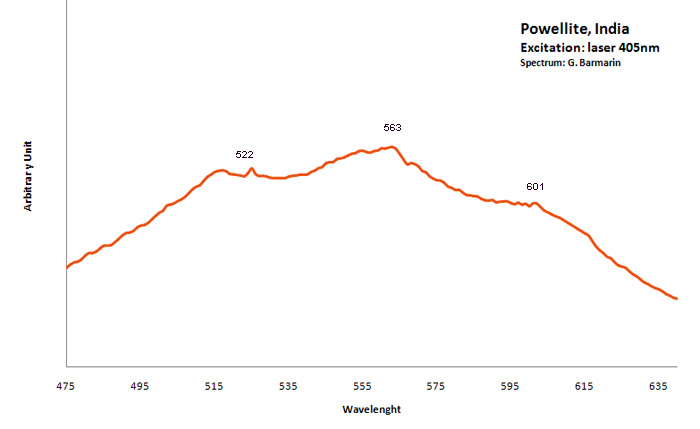Database of luminescent minerals
POWELLITE
Chemical formula: CaMoO4
Family: Tungstates, Molybdates
Status: IMA-GP
Crystal system : Tetragonal
Display mineral: OUI
Luminescence:
Longwave UV (365nm) colors: |
Yellowish White , | ||
Intensity LW:Weak | Frequency LW:Very rarely | ||
Shortwave UV (254nm) colors: |
Yellowish White , White , Bluish White , Pale Yellow , Greenish , Bluish Green , Greenish white , | ||
Intensity SW:Very Strong | Frequency SW:Always | ||
Daylight picture

POWELLITE, India.
Col. G.Barmarin; Photo: G. Barmarin
Shortwave (254nm) picture

POWELLITE, India.
OC (254 nm)
Col. G.Barmarin; Photo: G. Barmarin
Pictures Galery:



 ...
...  Go to the galery (12 pictures)
Go to the galery (12 pictures)
Do you have a photo of this mineral you would like to see in the gallery? Contact us!
Phosphorescence (in the common sense of the term) observable with the naked eye:
No data
Comments:
The tungstates of calcium, strontium, magnesium and zinc, and the molybdates of calcium are known to show luminescence upon excitation by cathode rays or short-wave ultra-violet radiation. It is commonly assumed that this luminescence is characteristic of the tungstate and molybdate groups. The reason why other tungstates and molybdates are found to be non-luminescent is probably the temperature-quenching (see Nature article by F. A. Kröger in 1947 in the bibliography).
Activator(s) and spectrum:
Activator(s): MoO42-, (UO2)2+ (ion Uranyle) en impureté, Er3+, Pr3+, Nd3+,
Peaks in the spectrum (nm):
MoO42- : Broad band peaking at 530 - 550 nm (Gorobets) (Lifetime: 30 μs) UO22+ : 650nm (uranyl complexes substituting to molybdenum (Panczer et al.)) Nd3+ : 810, 870nm

Col. G.Barmarin; Photo: G. Barmarin
Spectrum Galery:

 ...
...Comments on spectrum and activators:
The natural photoluminescence emission of ordered CaMoO4 is attributed to an intrinsic slight distortion of the [MoO4] tetrahedral goup. The decay time is 200 μs . Under 532 nm cw excitation the luminescence of Pr3+, Er3+, Nd3+ as well as [UO2]2+ were revealed in powellite found associated with pitchblende and molybdenite in South Kazakhstan (Bota-Burum Mo-U deposits). (Gaft)
Best localities for fluorescence (*):
- Pandulena quarry, Nasik district, India;
- Mahodari, Nasik, Pune (Poona), Maharashtra, India;
- Nangaon, Aurangabad District, Maharashtra, India;
- Jalgaon, Maharashtra, India;
- Ahmednagar District, Maharashtra, India;
- Shakur Quarry, Nashik District, Maharashtra, India (with celadonite inclusions, fluo green);
- Ultevis, Jokkmokk, Norrbotten County, Sweden;
- Jardinera No. 1 Mine, Inca de Oro mining district, Chañaral Province, Atacama, Chile;
(*)The data are not exhaustive and are limited to a few remarkable localities for fluorescence
Bibliographic reference for luminescence:
- The Henkel Glossary of Fluorescent Minerals, Dr. Gerhard Henkel, Published by the FMS, 1989 ,
- Fluorescence: Gems and Minerals Under Ultraviolet Light, Manuel Robbins, 1994, Geoscience Press, ISBN 0-945005-13-X ,
- The World of Fluorescent Minerals, Stuart Schneider, Schiffer Publishing, 2006, ISBN 0-7643-2544-2 ,
- Luminescent Spectra of Minerals, Boris S. Gorobets and Alexandre A. Rogojine, Moscow, 2002 ,
Reference for luminescence on the Internet:
- The Langesundsfjord: history, geology, pegmatites, minerals, Alf Olav Larsen, Bode Verlag Gmbh, 2010 ISBN 978-3-925094-97-2
- F. A. KRÖGER , Fluorescence of Tungstates and Molybdates,Nature,159, pages674–675(1947)
- MONT-SAINT-HILAIRE, History, Geology, Mineralogy, Laszlo HORVATH, The Canadian Mineralogist, Special Publication 14, 2019
Images:
- Ultevis, Sweden: https://www.mindat.org/photo-167365.html
- Jardinera No. 1 Mine, Atacama, Chile: https://www.mindat.org/photo-143047.html
- Nashik, India (with celadonite inclusions, fluo green): https://www.mindat.org/photo-201265.html
- Nashik, India: https://www.mindat.org/photo-625344.html
- Franklin, NJ, USA: https://www.mindat.org/photo-901746.html
Mineralogical reference on the Internet:
 http://www.mindat.org/show.php?name=Powellite
http://www.mindat.org/show.php?name=Powellite
 http://webmineral.com/data/Powellite.shtml
http://webmineral.com/data/Powellite.shtml
Internet Search:
 Image search on 'Google Images'
Image search on 'Google Images'
 Search for documents in all languages on Google
Search for documents in all languages on Google
A request providing no result means only that no such reference exists in the database, but it does not mean that what you are looking for does not exist, just not to our knowledge. If you think you have found an error or omission, please let us know via the contact page being sure to cite the source of information.
